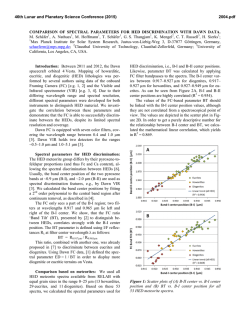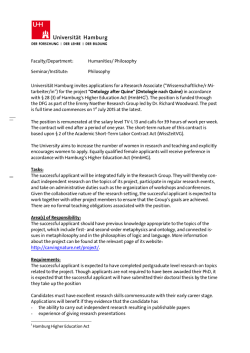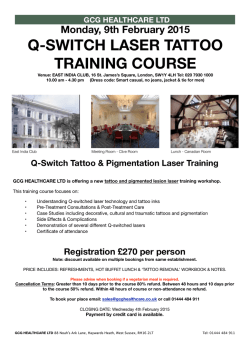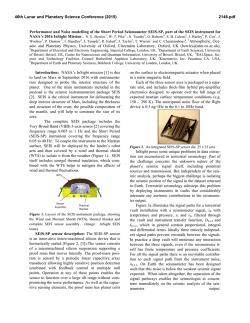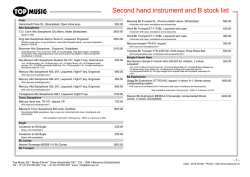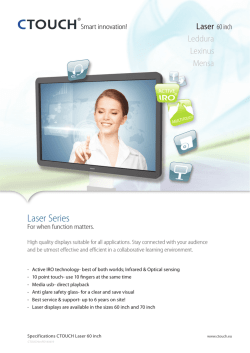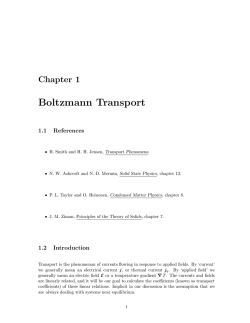
The HED Instrument
update: HED science instrument (web version) European XFEL Users’ Meeting January 28, 2015 Thomas Tschentscher for HED [email protected] HED instrument High Energy Density Science – HED 2 Ultrafast dynamics and structural properties of matter at extreme states Highly excited solids laser processing, dynamic compression, high B-field Near-solid density plasmas WDM, HDM, rel. laser-matter interaction Quantum states of matter high field QED Samples generated by pulsed excitation Highly dynamic and often non-equilibrium Irreversible processes sample refreshment required Combination of high excitation with various x-ray techniques Use of various pump sources to excite samples (OL, XFEL, ext. fields) Thomas Tschentscher, European XFEL, European XFEL Users’ Meeting, Hamburg 28/01/2015 HED instrument HED unique properties 3 Integration of x-ray FEL with high power laser systems and pulsed high magnetic fields 100 J, ns high-energy (HE) laser for dynamic compression * 4 J, 40 fs ultrahigh-intensity (UHI) laser for relativistic laser-matter interaction * 50 T, ~ms pulsed magnetic fields for condensed matter studies at high fields * Utilization of high repetition rates Up to 4.5 MHz for non-destructive experiments Up to 10 Hz for destructive experiments Provision of dedicated scattering setups Chamber for high energy laser-drive and various types x-ray scattering Setup for DAC (in air) diffraction * Setup for diffraction from specimen inside pulsed magnetic coil * Thomas Tschentscher, European XFEL, European XFEL Users’ Meeting, Hamburg 28/01/2015 * external funding (HIBEF) HED instrument Integration of HED and HIBEF UC 4 Helmholtz International Beamline for Extreme Fields (HIBEF) This User Consortium proposes to contribute critical instrumentation exceeding the baseline scope of the HED instrument. HIBEF is based on a wide community of users from plasma and high pressure physics solid-state physics material sciences The significant contributions are driven by the needs for the respective exps. high energy lasers – magnetic pulser – DAC and high B setups – spectrometer many more have been mentioned Integration supervised & coordinated by HED requires HIBEF staff to be integrated includes future operation Thomas Tschentscher, European XFEL, European XFEL Users’ Meeting, Hamburg 28/01/2015 HIBEF executive Coordinator: C. Baehtz (HZDR) Executive board: T. Cowan (HZDR), R. Redmer (U Rostock), J. Wark (U Oxford), E. Weckert (DESY), NN HED instrument DIPOLE 100-X* 5 UK contribution to HIBEF HE laser delivering ns pulses with ~100 J pulse energy Diode-pumped, cryogenic amplifier 10 Hz capability Pulse-shaping capability Grants awarded by EPSRC and STFC to U Oxford and CLF Work has commenced in fall 2014 Integration has started Ambitious developments ahead Operational flexibility Pulse-shaping Frequency conversion Optical isolation Thomas Tschentscher, European XFEL, European XFEL Users’ Meeting, Hamburg 28/01/2015 * external funding (HIBEF) HED instrument 2014 at HED Completed, reviewed and published Technical Design Report (TDR) Reported at last UM, followed by User Workshop & HED-ART meeting XFEL.EU TR-2014-001; see www.xfel.eu/documents/technical_documents Civil construction of HED-EXP enclosure Heavy concrete construction to enable use of ultrahigh intensity lasers Design of HED components X-ray beam delivery (attenuators, slits, CRLs IKC by Denmark) Interaction chamber 1 (IA1) – main work horse Overall instrument layout Optical laser installations Continued definition of HIBEF User Consortium contributions Work on DIPOLE 100-X started Other contributions still under definition Thomas Tschentscher, European XFEL, European XFEL Users’ Meeting, Hamburg 28/01/2015 6 HED instrument Refined HED model (3D) 7 HED Laser room HED Rck2 HED Controls hutch HED Rck2 Prep. room X-ray beam HED Optics hutch Thomas Tschentscher, European XFEL, European XFEL Users’ Meeting, Hamburg 28/01/2015 HED Experiment hutch HED instrument X-ray optics hutch (HED-OPT) Pop in monitor PP, X-ray timing Attenuator QWP (HIBEF) CRL Shutter 4 blade slits BSM X-ray beam delivery Top view Thomas Tschentscher, European XFEL, European XFEL Users’ Meeting, Hamburg 28/01/2015 Open space EXP HED instrument HED-EXP HED experiments enclosure 95% completed To come: crane chicanes Thomas Tschentscher, European XFEL, European XFEL Users’ Meeting, Hamburg 28/01/2015 9 HED instrument HED-Laserroom (DIPOLE-100-X & UHI model) HED Rck1 UHI-OL UHI-OL down (exact layout to be determined) HE-OL down DIPOLE-100-X HED Rck2 Thomas Tschentscher, European XFEL, European XFEL Users’ Meeting, Hamburg 28/01/2015 10 HED instrument HED experiment hutch 11 OL IA1 IA2 (HIBEF) OL Thomas Tschentscher, European XFEL, European XFEL Users’ Meeting, Hamburg 28/01/2015 HED instrument Interaction chamber 1 (IA1) 12 Side view X-ray techniques XRD, IXS, XAS, SAXS. Imaging, … OL techniques VISAR, FDI, microscopy, … Thomas Tschentscher, European XFEL, European XFEL Users’ Meeting, Hamburg 28/01/2015 Top view HED instrument Area detector issues 13 Several experimental techniques require (large) area detectors Spectroscopy (XAS, IXS (hr, plasmon,Compton)) – 2D improves selectivity Imaging (Ptychography, PCI, Coh-Imaging) – distance requirements Diffraction (crystals, powders, liquids/amorphous) – Large θ angle coverage ⇒ High expectation by user community Specific issues Forward scattering: detectors/windows vs. intense FEL beam Debris from sample expansion EMP from laser pulses ⇒ Conflicting requirements Thomas Tschentscher, European XFEL, European XFEL Users’ Meeting, Hamburg 28/01/2015 HED instrument Forward diffraction experiments 14 Typical requirements (for class of exps.) large area detectors close to the sample (scatterer) to provide max. coverage of θ angle/Q-space cover min. 90°, better 180°in ϕ (azimuthal angle) often mounted on x-ray axis to cover 360° in ϕ Two scenarios 1. mount tile(s) in-vacuum 2. Put large area outside vacuum & off-axis 1. Thomas Tschentscher, European XFEL, European XFEL Users’ Meeting, Hamburg 28/01/2015 2. 1st priority 2nd priority HED instrument Area detector issues 15 Several experimental techniques require (large) area detectors Spectroscopy (XAS, IXS (hr, plasmon,Compton)) – 2D improves selectivity Imaging (Ptychography, PCI, Coh-Imaging) – distance requirements Diffraction (crystals, powders, liquids/amorphous) – Large θ angle coverage ⇒ High expectation by user community Specific issues Forward scattering: detectors/windows vs. intense FEL beam Debris from sample expansion EMP from laser pulses ⇒ Conflicting requirements Start of operations Abandon idea to include large area, in-vacuum, full-reprate detector Place ‘smallish’ area detectors inside vacuum; EMP tested Continue search for possible large area detector solutions Thomas Tschentscher, European XFEL, European XFEL Users’ Meeting, Hamburg 28/01/2015 HED instrument Concrete detector choices AGIPD + Full rep-rate capability – Weight & complexity – Pixel size (220 µm) Jungfrau + 1MHz/16-pulse capability + Pixel size (75 µm) – Vacuum capability MPCCD + Pixel size (50 µm) + EMP tests (SACLA) – max 10 Hz rep rate – red. dyn range – red. sensitivity Thomas Tschentscher, European XFEL, European XFEL Users’ Meeting, Hamburg 28/01/2015 16 Parameter AGIPD Jungfrau MPCCD Sensor 500 µm Si 500 µm Si 300 µm Si Dyn. range 10^4 10^4 10^3 Noise ~300 e- ~180 e- ~300 e- a possible scenario: MPCCD Jungfrau AGIPD use in-vacuum large area out of vacuum future extension in addition: epix, large area scient. CCDs HED instrument Damage issues – windows Several requests for experiments outside vacuum or in special environments (e.g. DAC, vacuum for very low temperatures: high B fields) ⇒ need to solve the issue of interaction with intense x-ray beam ⇒ Limits for min. beam size and/or max. pulse energy 1. For experiments at repetition rates of 10 Hz (or less): absorbed dose needs to stay clearly below the dose enabling damage Simulations (V. Lyamayev): 100 µJ for ∅ ~ 2 µm (for diamond & 20 keV) 2. For experiments aiming at multiple pulses within (10 Hz) pulse train: absorbed energy needs to stay clearly below the energy required for melting or structural phase transitions Simulations (V. Lyamayev) : on-going In case of HE/UHI laser beam add. risks due to sample debris fragments Thomas Tschentscher, European XFEL, European XFEL Users’ Meeting, Hamburg 28/01/2015 17 HED instrument Early experiment program 18 Available X-ray beam (8 – 12 keV) – limited flexibility/parameters PP-OL X-ray transport/diagnostics (incl. x-ray-OL cross-correlation measurement) High magnetic fields and DAC setup Not available Large laser systems (HE-OL & UHI-OL) still under installation/commissioning First experiments X-ray-matter interactions Probed by x-ray (self-)scattering, x-ray emission, OL techniques fs-mJ // 100 mJ-ps OL excitation Probed by x-ray scattering Solids in high magnetic fields & at high P-T (DAC) Probed by x-ray scattering Thomas Tschentscher, European XFEL, European XFEL Users’ Meeting, Hamburg 28/01/2015 HED instrument Next steps & Conclusion Time to 1st x-ray beam is little more than 2 years Rooms and infrastructure will be completed 2016 X-ray delivery systems will be available 2016 First x-rays during 1st half 2017 Early user experiments to start in fall 2017 Optical lasers systems will become available during 2017 PP-OL: ~summer 2017 HE-OL: ~end 2017 UHI-OL: 2018 ⇒HED instrument will be available in time for first x-rays ⇒First experiments probably using x-rays only and PP-OL Thomas Tschentscher, European XFEL, European XFEL Users’ Meeting, Hamburg 28/01/2015 19 HED instrument The HED team plus 20 More about the HED instrument during this meeting: Motoaki Nakatsutsumi Tomorrow, Karen Appel Ian Thorpe Gerd Priebe (OL) Alexander Pelka (HZDR) Andreas Schmidt 14 hrs – HED Users Workshop, Bldg 99 (CFEL), Sem Rm 1 15:50 hrs – HIBEF User & General Assembly meeting, Bldg 99 (CFEL), Sem Rm 1 CIE team Laser group Friday, 14:30 hrs – Postersession,Lewis FLASH2 hall Batchelor, Antonios Lalechos, Osama, Gerd Priebe, Guido Palmer & Max Lederer Viktor Lyamayev & Wolfgang Tscheu 196 – The HED instrument 207 – Observing MGauss by Faraday rotation + PSPO, diagnostics, 299 –Photon Dynamic Diamond Anvil Cell experiments Detector, 314 – Equilibration dynamics in hydrogen DAQ/Ctrl groups Sample environment group … and probably more XROBT group Joachim Schulz, Carsten Deiter, James Moore Harald Sinn, Fan Yang, Martin Dommach Thomas Tschentscher, European XFEL, European XFEL Users’ Meeting, Hamburg 28/01/2015
© Copyright 2026
